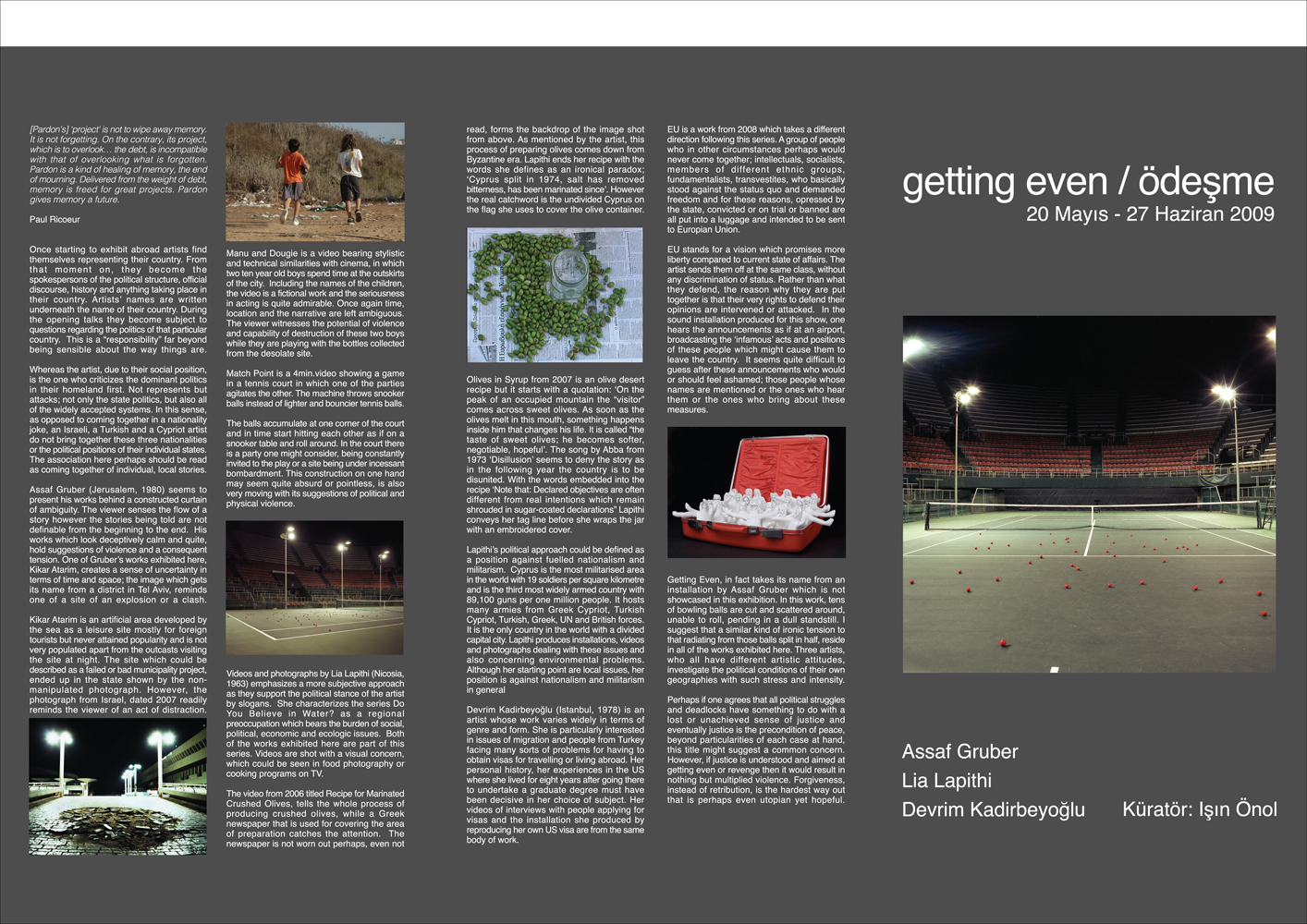GETTING EVEN
MAY – JUNE 2009
GETTING EVEN
Sabanci University Kasa Gallery, Istanbul, Turkey
Artists:
Assaf Gruber | Lia Lapithi | Devrim Kadirbeyoglu
Curator: Isin Önol
website of the event
[Pardon’s] ‘project’ is not to wipe away memory. It is not forgetting. On the contrary, its project, which is to overlook… the debt, is incompatible with that of overlooking what is forgotten. Pardon is a kind of healing of memory, the end of mourning. Delivered from the weight of debt, memory is freed for great projects. Pardon gives memory a future.
Paul Ricoeur
Once starting to exhibit abroad artists find themselves representing their country. From that moment on, they become the spokespersons of the political structure, official discourse, history and anything taking place in their country. Artists’ names are written underneath the name of their country. During the opening talks they become subject to questions regarding the politics of that particular country. This is a “responsibility” far beyond being sensible about the way things are. Whereas the artist, due to their social position, is the one who criticizes the dominant politics in their homeland first. Not represents but attacks; not only the state politics, but also all of the widely accepted systems. In this sense, as opposed to coming together in a nationality joke, an Israeli, a Turkish and a Cypriot artist do not bring together these three nationalities or the political positions of their individual states. The association here perhaps should be read as coming together of individual, local stories.
Assaf Gruber (Jerusalem, 1980) seems to present his works behind a constructed curtain of ambiguity. The viewer senses the flow of a story however the stories being told are not definable from the beginning to the end. His works which look deceptively calm and quite, hold suggestions of violence and a consequent tension.
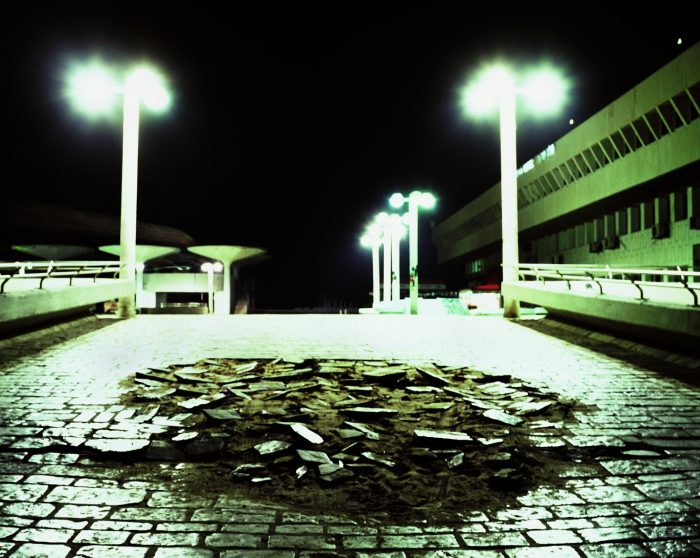
One of Gruber’s works exhibited here, Kikar Atarim, creates a sense of uncertainty in terms of time and space; the image which gets its name from a district in Tel Aviv, reminds one of a site of an explosion or a clash. Kikar Atarim is an artificial area developed by the sea as a leisure site mostly for foreign tourists but never attained popularity and is not very populated apart from the outcasts visiting the site at night. The site which could be described as a failed or bad municipality project, ended up in the state shown by the non-manipulated photograph. However, the photograph from Israel, dated 2007 readily reminds the viewer of a terrorist attack or war.

Manu and Dougie is a video bearing stylistic and technical similarities with cinema, in which two ten year old boys spend time at the outskirts of the city. Including the names of the children, the video is a fictional work and the seriousness in acting is quite admirable. Once again time, location and the narrative are left ambiguous. The viewer witnesses the potential of violence and capability of destruction of these two boys while they are playing with the bottles collected from the desolate site.
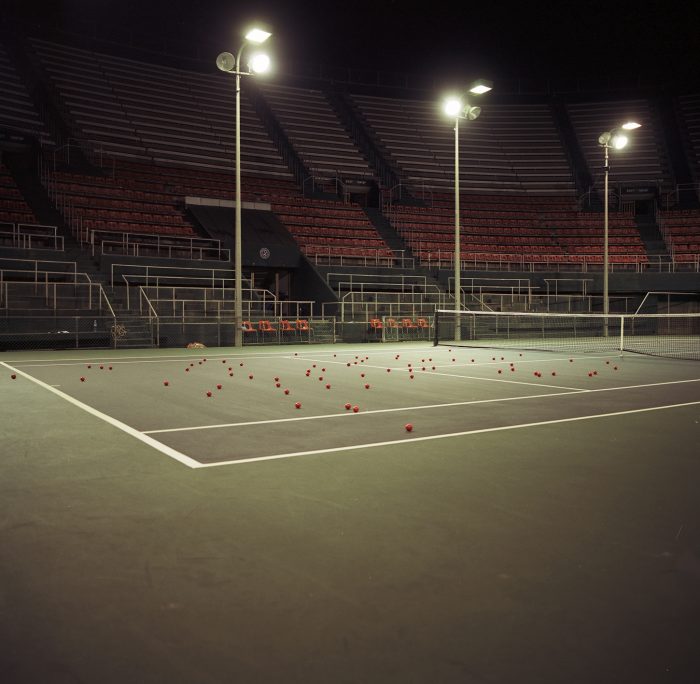
Match Point is a 4min.video showing a game in a tennis court in which one of the parties agitates the other. The machine throws snooker balls instead of lighter and bouncier tennis balls. The balls accumulate at one corner of the court and in time start hitting each other as if on a snooker table and roll around. In the court there is a party one might consider, being constantly invited to the play or a site being under incessant bombardment. This construction on one hand may seem quite absurd or pointless, is also very moving with its suggestions of political and physical violence.
Videos and photographs by Lia Lapithi (Nicosia, 1963) emphasizes a more subjective approach as they support the political stance of the artist by slogans. She characterizes the series Do You Believe in Water? as a regional preoccupation which bears the burden of social, political, economic and ecologic issues. Both of the works exhibited here are part of this series. Videos are shot with a visual concern, which could be seen in food photography or cooking programs on TV.

The video from 2006 titled Recipe for Marinated Crushed Olives, tells the whole process of producing crushed olives, while a Greek newspaper that is used for covering the area of preparation catches the attention. The newspaper is not worn out perhaps, even not read, forms the backdrop of the image shot from above. As mentioned by the artist, this process of preparing olives comes down from Byzantine era. Lapithi ends her recipe with the words she defines as an ironical paradox; ‘Cyprus split in 1974, salt has removed bitterness, has been marinated since’. However the real catchword is the undivided Cyprus on the flag she uses to cover the olive container.
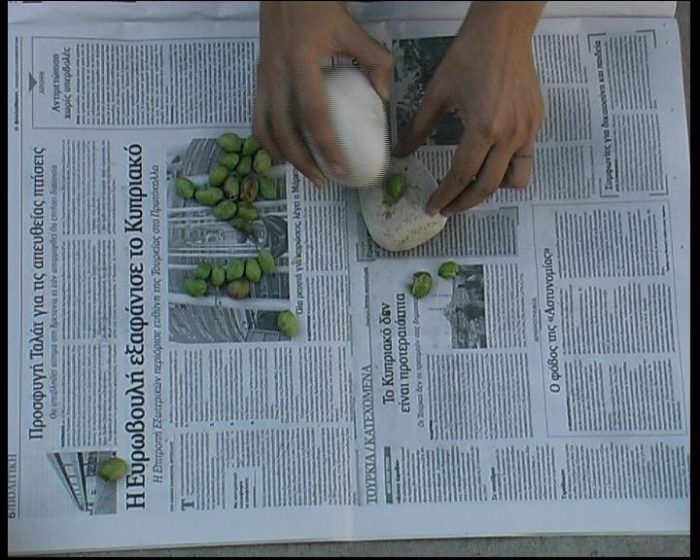
Olives in Syrup from 2007 is an olive desert recipe but it starts with a quotation: ‘On the peak of an occupied mountain the “visitor” comes across sweet olives. As soon as the olives melt in this mouth, something happens inside him that changes his life. It is called “the taste of sweet olives; he becomes softer, negotiable, hopeful’. The song by Abba from 1973 ‘Disillusion’ seems to deny the story as in the following year the country is to be disunited. With the words embedded into the recipe ‘Note that: Declared objectives are often different from real intentions which remain shrouded in sugar-coated declarations” Lapithi conveys her tag line before she wraps the jar with an embroidered cover.

Lapithi’s political approach could be defined as a position against fuelled nationalism and militarism. Cyprus is the most militarised area in the world with 19 soldiers per square kilometre and is the third most widely armed country with 89,100 guns per one million people. It hosts many armies from Greek Cypriot, Turkish Cypriot, Turkish, Greek, UN and British forces. It is the only country in the world with a divided capital city. Lapithi produces installations, videos and photographs dealing with these issues and also concerning environmental problems. Although her starting point is on local issues, her position is against nationalism and militarism in general.

Devrim Kadirbeyoğlu (Istanbul, 1978) is an artist whose work varies widely in terms of genre and form. She is particularly interested in issues of migration and people from Turkish citizens facing many sorts of problems for having to obtain visas for travelling or living abroad. Her personal history, her experiences in the US where she lived for eight years after going there to undertake a graduate degree must have been decisive in her choice of this subject. Her videos of interviews with people applying for visas and the installation she produced by reproducing her own US visa are from the same body of work.

EU is a work from 2008 which takes a different direction following this series. A group of people who in other circumstances perhaps would never come together; intellectuals, fundamentalists, transvestites, who are convicted or on trial or banned are all put into a luggage and intended to be sent to europian union. They are all sent off at the same class, no discrimination is done. Rather than what they defend, the reason why they are put together is that their very rights to defend their opinions are intervened or attacked. In the sound installation produced for this show, one hears the announcements as if at an airport, broadcasting the ‘infamous’ acts and positions of these people which might cause them to leave the country. It seems quite difficult to guess after these announcements who would or should feel ashamed; those people whose names are mentioned or the ones who hear them or the ones who bring about these measures.
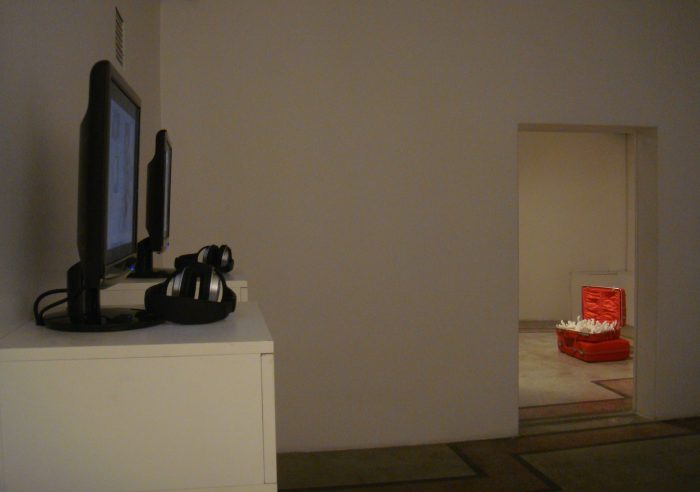
Getting Even, in fact takes its name from an installation by Assaf Gruber which is not showcased in this exhibition. In this work, tens of bowling balls are cut and scattered around, unable to roll, pending in a dull standstill. I suggest that a similar kind of ironic tension to that radiating from those balls split in half, reside in all of the works exhibited here. Three artists, who all have different artistic attitudes, investigate the political conditions of their own geographies with such stress and intensity.
Perhaps if one agrees that all political struggles and deadlocks have something to do with a lost or unachieved sense of justice and eventually justice is the precondition of peace, beyond particularities of each case at hand, this title might suggest a common concern. However, if justice is understood and aimed at getting even or revenge then it would result in nothing but multiplied violence. Forgiveness, instead of retribution, is the hardest way out that is perhaps even utopian yet hopeful.
photographs by the artists
![gettingeven2[1]](https://isinonol.com/wp-content/uploads/2013/02/gettingeven21.jpg)
